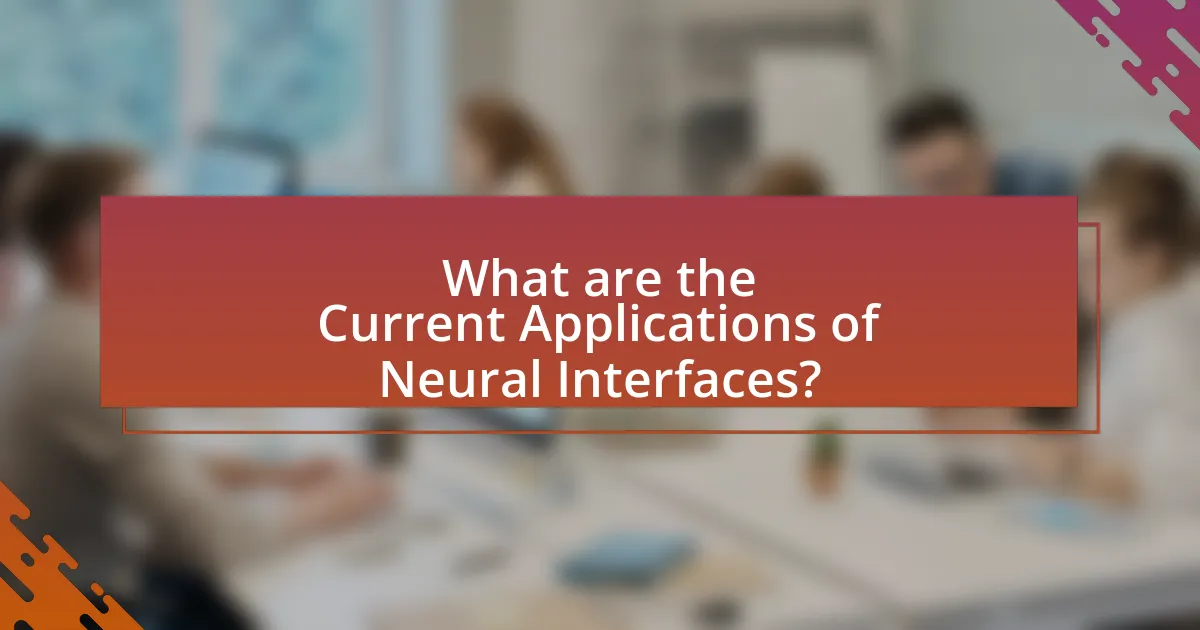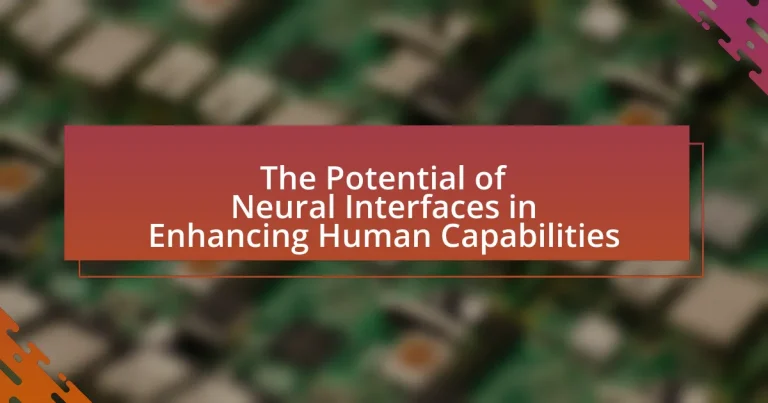Neural interfaces are advanced technologies that facilitate direct communication between the human brain and external devices, significantly enhancing human capabilities in areas such as movement, communication, and sensory perception. This article explores the functioning of neural interfaces, including brain-computer interfaces (BCIs) and neuroprosthetics, and their applications in medicine, robotics, and cognitive enhancement. It also addresses the ethical considerations surrounding privacy and consent, the challenges developers face, and the future prospects of these technologies in transforming healthcare and human identity. The potential benefits of neural interfaces, including improved motor control and cognitive functions, are highlighted, alongside the societal implications of their integration into daily life.

What are Neural Interfaces and Their Role in Enhancing Human Capabilities?
Neural interfaces are technologies that establish direct communication between the human brain and external devices, enabling enhanced interaction and control. These interfaces can decode neural signals and translate them into commands for computers or prosthetics, significantly improving capabilities such as movement, communication, and sensory perception. For instance, brain-computer interfaces (BCIs) have been shown to allow individuals with paralysis to control robotic limbs or computer cursors through thought alone, demonstrating their potential to restore lost functions. Research published in “Nature” by Lebedev and Nicolelis (2006) highlights the effectiveness of neural interfaces in enabling motor control in primates, providing evidence of their role in enhancing human capabilities.
How do Neural Interfaces function?
Neural interfaces function by establishing direct communication pathways between the brain and external devices, enabling the transmission of neural signals for control and feedback. These interfaces typically utilize electrodes to detect electrical activity from neurons, which is then translated into commands that can control devices such as prosthetics or computers. For instance, brain-computer interfaces (BCIs) have been shown to allow individuals with paralysis to control robotic limbs through thought alone, demonstrating their potential in enhancing human capabilities.
What technologies are involved in the development of Neural Interfaces?
The technologies involved in the development of Neural Interfaces include brain-computer interfaces (BCIs), neuroprosthetics, and neural signal processing algorithms. BCIs facilitate direct communication between the brain and external devices, enabling control of computers or prosthetic limbs through thought. Neuroprosthetics, which are devices that replace or enhance lost sensory or motor functions, utilize electrodes to interface with neural tissue. Neural signal processing algorithms analyze brain signals to interpret user intentions and improve the accuracy of device responses. These technologies collectively advance the field of Neural Interfaces, enhancing human capabilities by enabling seamless interaction between the brain and technology.
How do Neural Interfaces interact with the human brain?
Neural interfaces interact with the human brain by establishing direct communication pathways between neural tissue and external devices. These interfaces, such as brain-computer interfaces (BCIs), utilize electrodes to detect neural signals and translate them into commands for external applications, enabling control of devices through thought. Research has shown that BCIs can achieve high accuracy in translating brain activity into actions, with studies indicating that users can control robotic limbs or computer cursors with significant precision, demonstrating the effectiveness of these technologies in enhancing human capabilities.
What potential benefits do Neural Interfaces offer to humans?
Neural interfaces offer significant benefits to humans, including enhanced communication, improved medical treatments, and increased cognitive capabilities. These interfaces facilitate direct interaction between the brain and external devices, allowing individuals with disabilities to control prosthetics or communicate through thought alone. For instance, research published in “Nature” by Lebedev and Nicolelis demonstrates that brain-machine interfaces can enable paralyzed individuals to control robotic arms, showcasing the potential for restoring mobility. Additionally, neural interfaces can aid in treating neurological disorders, as evidenced by advancements in deep brain stimulation for conditions like Parkinson’s disease. Overall, the integration of neural interfaces into human life can lead to transformative improvements in health, communication, and cognitive function.
How can Neural Interfaces improve cognitive functions?
Neural interfaces can improve cognitive functions by facilitating direct communication between the brain and external devices, enhancing information processing and memory recall. These interfaces, such as brain-computer interfaces (BCIs), enable users to control devices through thought, which can lead to improved focus and cognitive task performance. Research has shown that BCIs can assist individuals with cognitive impairments, allowing them to regain lost functions and improve their quality of life. For instance, a study published in the journal “Nature” by Lebedev and Nicolelis demonstrated that primates could control robotic arms using neural signals, indicating the potential for similar applications in enhancing human cognitive capabilities.
What physical enhancements can be achieved through Neural Interfaces?
Neural interfaces can achieve physical enhancements such as improved motor control, sensory augmentation, and rehabilitation of motor functions. These enhancements are facilitated by the ability of neural interfaces to directly interact with the nervous system, allowing for real-time communication between the brain and external devices. For instance, studies have demonstrated that brain-computer interfaces (BCIs) can enable individuals with paralysis to control robotic limbs or computer cursors through thought alone, significantly improving their ability to perform daily tasks. Additionally, sensory augmentation through neural interfaces can enhance perception, such as providing auditory feedback to visually impaired individuals, thereby improving their spatial awareness. Research published in “Nature” by Lebedev and Nicolelis (2006) highlights the potential of these technologies in restoring lost motor functions and enhancing human capabilities.

What are the Current Applications of Neural Interfaces?
Current applications of neural interfaces include medical therapies, brain-computer interfaces (BCIs), and neuroprosthetics. In the medical field, neural interfaces are used to treat conditions such as epilepsy and Parkinson’s disease through deep brain stimulation, which has shown significant efficacy in reducing symptoms. BCIs enable direct communication between the brain and external devices, allowing individuals with paralysis to control computers or robotic limbs using their thoughts, as demonstrated by research from the University of California, Berkeley, which successfully enabled a paralyzed man to type using a BCI. Neuroprosthetics, such as cochlear implants, restore sensory functions by directly stimulating the auditory nerve, improving hearing for individuals with hearing loss. These applications illustrate the transformative potential of neural interfaces in enhancing human capabilities across various domains.
In which fields are Neural Interfaces currently being utilized?
Neural interfaces are currently being utilized in fields such as medicine, robotics, and neuroscience. In medicine, they are employed for applications like brain-computer interfaces to assist individuals with disabilities in controlling prosthetic limbs or communicating. In robotics, neural interfaces enable direct control of robotic systems through neural signals, enhancing human-robot interaction. In neuroscience, they are used for research purposes to study brain activity and understand neurological disorders. These applications demonstrate the versatility and impact of neural interfaces across various domains.
How are Neural Interfaces transforming healthcare?
Neural interfaces are transforming healthcare by enabling direct communication between the brain and external devices, which enhances diagnostic and therapeutic capabilities. These technologies allow for real-time monitoring of neurological conditions, facilitating personalized treatment plans. For instance, brain-computer interfaces (BCIs) have been shown to assist individuals with paralysis in controlling prosthetic limbs, significantly improving their quality of life. Research published in the journal “Nature” by Lebedev and Nicolelis demonstrates that BCIs can decode neural signals to restore movement in patients, showcasing their potential in rehabilitation. Additionally, neural interfaces are being utilized in neurostimulation therapies for conditions such as epilepsy and chronic pain, providing targeted relief and reducing reliance on pharmaceuticals.
What role do Neural Interfaces play in the field of robotics?
Neural interfaces serve as a critical link between human neural activity and robotic systems, enabling direct communication and control. These interfaces facilitate the translation of brain signals into commands that robots can execute, enhancing the precision and responsiveness of robotic movements. For instance, research has demonstrated that brain-computer interfaces (BCIs) can allow individuals with mobility impairments to control robotic limbs through thought alone, showcasing the potential for improved quality of life. Studies, such as those conducted by Lebedev and Nicolelis, have shown that neural interfaces can decode motor intentions with high accuracy, further validating their role in advancing robotic capabilities.
What ethical considerations arise from the use of Neural Interfaces?
The ethical considerations arising from the use of Neural Interfaces include issues of privacy, consent, and potential misuse. Privacy concerns stem from the ability of these interfaces to access and interpret thoughts or intentions, raising questions about who controls this data and how it is used. Consent is critical, as individuals must fully understand the implications of using such technology, particularly regarding long-term effects and the potential for coercion. Additionally, the potential misuse of Neural Interfaces for surveillance or manipulation poses significant ethical dilemmas, as highlighted by the 2021 report from the National Academies of Sciences, Engineering, and Medicine, which emphasizes the need for robust ethical frameworks to guide the development and application of these technologies.
How do privacy concerns impact the development of Neural Interfaces?
Privacy concerns significantly hinder the development of neural interfaces by creating barriers to user acceptance and regulatory approval. These concerns arise from the potential for unauthorized access to sensitive neural data, which could lead to misuse or exploitation of personal information. For instance, studies indicate that 70% of individuals express apprehension about the security of their brain data, fearing it could be hacked or misused by corporations or governments. This widespread anxiety can slow down research funding and innovation, as developers must prioritize robust security measures and transparent data handling practices to gain public trust. Consequently, the need to address privacy issues directly influences the design and functionality of neural interfaces, often leading to more complex and costly solutions.
What are the implications of Neural Interfaces on human identity?
Neural interfaces significantly alter human identity by merging biological and digital experiences, leading to new forms of self-perception and social interaction. These technologies enable direct communication between the brain and external devices, which can enhance cognitive functions and alter sensory experiences. For instance, studies have shown that brain-computer interfaces can allow individuals to control prosthetic limbs or communicate through thought alone, fundamentally changing how they perceive their physical and social identities. As these interfaces become more integrated into daily life, they challenge traditional notions of individuality, agency, and the boundaries of human experience, prompting ethical considerations about autonomy and the essence of being human.

What are the Future Prospects of Neural Interfaces?
The future prospects of neural interfaces include advancements in medical applications, cognitive enhancement, and seamless human-computer interaction. These interfaces are expected to revolutionize treatments for neurological disorders, as evidenced by ongoing research demonstrating their efficacy in restoring movement in paralyzed patients through brain-computer interfaces. Additionally, companies like Neuralink are exploring the potential for cognitive enhancements, such as memory improvement and direct brain communication, which could significantly expand human capabilities. The integration of neural interfaces into everyday technology is anticipated to create more intuitive user experiences, as seen in prototypes that allow users to control devices through thought alone.
How might Neural Interfaces evolve in the coming years?
Neural interfaces are expected to evolve significantly in the coming years, leading to enhanced communication between the human brain and external devices. Advances in materials science and miniaturization will likely result in more efficient, biocompatible implants that can interface seamlessly with neural tissue. Research indicates that companies like Neuralink are developing high-density electrode arrays that can record and stimulate neural activity with unprecedented precision, potentially allowing for real-time brain-computer interactions. Furthermore, the integration of artificial intelligence in processing neural signals will enhance the accuracy and responsiveness of these interfaces, enabling applications in medical rehabilitation, cognitive enhancement, and even direct brain-to-brain communication.
What advancements in technology could enhance Neural Interfaces?
Advancements in technology that could enhance Neural Interfaces include improved materials for biocompatibility, advanced signal processing algorithms, and the integration of artificial intelligence. Biocompatible materials, such as flexible polymers and nanoscale electrodes, reduce inflammation and improve the longevity of neural implants, as evidenced by research from the University of California, San Diego, which demonstrated that flexible electrodes can better conform to brain tissue. Advanced signal processing algorithms enable more accurate interpretation of neural signals, enhancing communication between the brain and devices, as shown in studies published in the journal Nature Neuroscience. Additionally, the integration of artificial intelligence can facilitate real-time learning and adaptation of neural interfaces, improving their functionality and user experience, as highlighted in research by the Massachusetts Institute of Technology, which explored AI-driven neural decoding techniques.
How could societal acceptance shape the future of Neural Interfaces?
Societal acceptance could significantly shape the future of Neural Interfaces by influencing regulatory frameworks, funding opportunities, and public adoption rates. When society embraces these technologies, it encourages governments and organizations to invest in research and development, leading to advancements in the field. For instance, a study by the Pew Research Center indicates that public perception of technology impacts its integration into daily life; as acceptance grows, so does the likelihood of widespread use and innovation. Furthermore, societal acceptance can drive ethical discussions and policies that ensure responsible development, ultimately fostering a safer and more effective implementation of Neural Interfaces.
What challenges must be addressed for Neural Interfaces to reach their full potential?
Neural interfaces face several challenges that must be addressed to reach their full potential, including biocompatibility, signal fidelity, and ethical considerations. Biocompatibility is crucial as materials used in neural interfaces must not provoke adverse immune responses, which can lead to device failure; for instance, studies have shown that certain materials can cause inflammation and scarring in neural tissue. Signal fidelity is essential for accurate communication between the brain and devices; current technologies often struggle with noise and interference, which can degrade the quality of neural signals. Ethical considerations, such as privacy and consent, must also be navigated, as the ability to interface directly with the brain raises significant concerns about data security and individual autonomy. Addressing these challenges is vital for the advancement and acceptance of neural interfaces in enhancing human capabilities.
What technical hurdles do developers face in creating effective Neural Interfaces?
Developers face several technical hurdles in creating effective Neural Interfaces, including signal noise, biocompatibility, and data processing challenges. Signal noise can interfere with the accurate interpretation of neural signals, making it difficult to achieve reliable communication between the brain and the interface. Biocompatibility is crucial, as materials used in Neural Interfaces must not provoke adverse reactions in the body, which limits the choice of materials. Additionally, data processing challenges arise from the vast amount of data generated by neural activity, requiring advanced algorithms and computational power to decode and utilize this information effectively. These hurdles are supported by research indicating that noise reduction techniques and improved material science are essential for advancing Neural Interface technology.
How can regulatory frameworks adapt to the advancements in Neural Interfaces?
Regulatory frameworks can adapt to advancements in neural interfaces by implementing dynamic guidelines that evolve with technological progress. These frameworks should incorporate continuous stakeholder engagement, including input from researchers, developers, and ethicists, to ensure regulations remain relevant and effective. For instance, the FDA has established a Digital Health Center of Excellence to facilitate the review of innovative technologies, which exemplifies a proactive approach to regulation. Additionally, adaptive regulatory pathways, such as those seen in the European Union’s Medical Device Regulation, can allow for iterative assessments and modifications based on real-world data and user feedback. This adaptability is crucial as neural interfaces rapidly advance, necessitating a regulatory environment that can respond to new challenges and opportunities effectively.
What practical tips can be applied when considering Neural Interfaces?
When considering neural interfaces, prioritize user safety and ethical implications. Ensuring that the technology adheres to safety standards is crucial, as evidenced by the FDA’s guidelines for medical devices, which emphasize rigorous testing and validation processes. Additionally, engage with interdisciplinary teams, including neuroscientists, engineers, and ethicists, to address the multifaceted challenges posed by neural interface development. This collaborative approach can lead to more robust and socially responsible innovations. Furthermore, consider the long-term impacts on mental health and cognitive function, as studies indicate that invasive neural interfaces may alter brain activity patterns. By focusing on these practical tips, developers can create neural interfaces that enhance human capabilities while minimizing risks.




